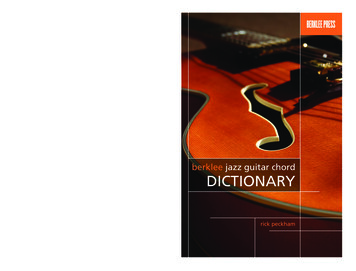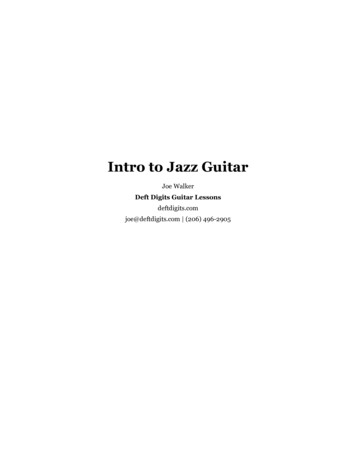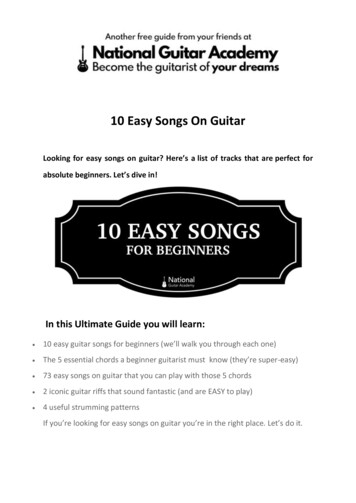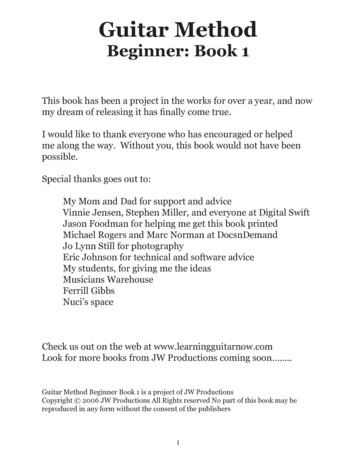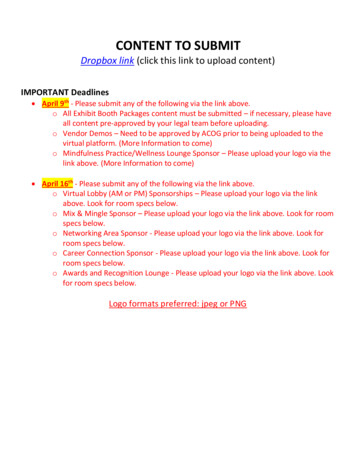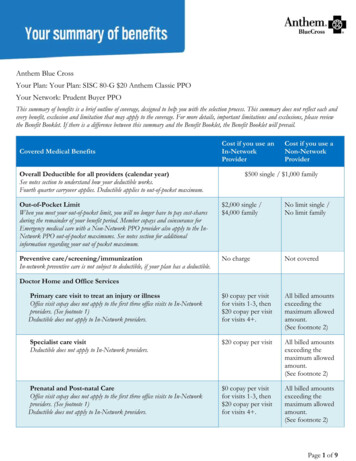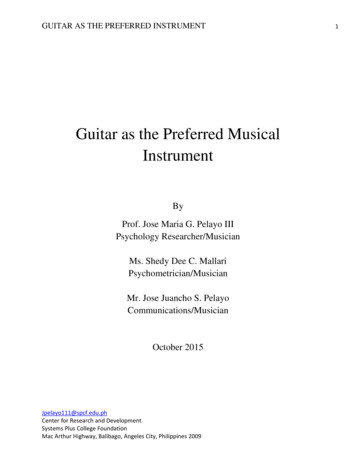
Transcription
GUITAR AS THE PREFERRED INSTRUMENTGuitar as the Preferred MusicalInstrumentByProf. Jose Maria G. Pelayo IIIPsychology Researcher/MusicianMs. Shedy Dee C. MallariPsychometrician/MusicianMr. Jose Juancho S. PelayoCommunications/MusicianOctober 2015Jpelayo111@spcf.edu.phCenter for Research and DevelopmentSystems Plus College FoundationMac Arthur Highway, Balibago, Angeles City, Philippines 20091
GUITAR AS THE PREFERRED INSTRUMENT2ABSTRACTThe Guitar is a very popular instrument that is commonly used by manymusicians. This study focused on the factors that made the guitar moreappealing to the youth in comparison to other instruments. A semistructured, open ended questionnaire was used to collect the dataessential for this study. 50 male and 50 female college students wereinterviewed in this study. The data was thematically coded to acquire theresults and conclusions. Purposive sampling was used in this researchstudy and the average age of both male and female respondents is 19years old. The results suggested that the guitar was more appealing totheir generation, affordable to purchase and had a distinct image as amusician and songwriter. The study focused on acoustic guitar playersand composers.Keywords: College Students,Songwriting, Musical InstrumentGuitar,Jpelayo111@spcf.edu.phCenter for Research and DevelopmentSystems Plus College FoundationMac Arthur Highway, Balibago, Angeles City, Philippines 2009Acoustic,Youth,Music,
GUITAR AS THE PREFERRED INSTRUMENTBACKGROUNDThe Guitar, classified as a six string instrument, is very popularspecifically the acoustic guitar, which is used in various methods ofplaying. It is commonly played with the left hand for the chords andright hand for plucking or strumming. Some consider the guitar is a typeof chordophone, traditionally constructed from wood with nylon or steelstrings and distinguished from other chordophones by its nature andtuning. The modern guitar was based by the gittern, the vihuela, thefour-course Renaissance guitar, and the five-course baroque guitar, all ofwhich attributed to the construction of the modern six-string instrument.The main types of modern acoustic guitar are the classical guitar (nylonstring guitar), the steel-string acoustic guitar, and the archtop guitar.Vibration is the root of the tone of the guitar strings, which is amplifiedby the body of the guitar that serves as a resonating tool to produce thesound of every string. The classical guitar is often played as a soloinstrument using a comprehensive fingerpicking technique.Electric guitars, introduced in the 1930s, use an amplifier that canelectronically manipulate and shape the tone. Early amplified guitarsemployed a hollow body, but a solid body was eventually found moresuitable, as it was less prone to feedback. Electric guitars have had acontinuing profound influence on popular culture. (guitar.com)Jpelayo111@spcf.edu.phCenter for Research and DevelopmentSystems Plus College FoundationMac Arthur Highway, Balibago, Angeles City, Philippines 20093
GUITAR AS THE PREFERRED INSTRUMENTMETHODOLOGYParticipants50 male and 50 female college students from Angeles City, Pampanga,Philippines were the respondents in the study. Their average age is 19years old. The respondents’ age when started to play guitar is 10.5 yearsold. All of them are songwriters and vocalists. The respondents are allperforming public in school, church, music bars and in specialoccasions.SamplingPurposive sampling was used in this study. All of the respondents wereplaying guitar, performing in public, songwriters and vocalists.Instruments UsedA semi structured, open ended questionnaire was used and also arecorded interview was the basis of this research study.Jpelayo111@spcf.edu.phCenter for Research and DevelopmentSystems Plus College FoundationMac Arthur Highway, Balibago, Angeles City, Philippines 20094
GUITAR AS THE PREFERRED INSTRUMENTSIGNIFICANCE OF THE STUDY/ SCOPE AND LIMITATIONSThis study would be a basis for the acknowledgement, subliminally orconsciously, why the guitar was and is a preferred musical instrumentcompared to others. This may guide musicians, parents, and educatorsthat the youth have an interest in music and specifically the use of theguitar. This study will only limit the scope on the use of guitar,specifically acoustic guitar, and all the aspects of singing, songwriting,and the use of the instrument as an expression of their emotions.Many musicians, just like the respondents have a certain artisticdexterity that may serve as an outlet of their feelings and emotions. Suchas listening to music and remembering certain situations in their life.The researchers acknowledge the fact that further studies or researchshould be conducted in order to solidify and enhance the results of thispilot study.PARTS OF THE GUITAR(ABOUT.COM GUITAR)At the point in which the headstock meets the neck of the guitar, you'llfind the "nut". A nut is simply a small piece of material (plastic, bone,etc.), in which small grooves are carved out to guide the strings up to thetuners.The neck of the guitar is the area of the instrument you'll concentrate agreat deal on: you'll put your fingers on various places on the neck, inorder to create different notes.Jpelayo111@spcf.edu.phCenter for Research and DevelopmentSystems Plus College FoundationMac Arthur Highway, Balibago, Angeles City, Philippines 20095
GUITAR AS THE PREFERRED INSTRUMENTThe neck of the guitar adjoins the "body" of the instrument. The body ofthe guitar will vary greatly from guitar to guitar. Most acoustic andclassical guitars have a hollowed out body, and a "sound hole", designedto project the sound of the guitar. Most electric guitars have a solidbody, and thus will not have a sound hole. Electric guitars will insteadhave "pick-ups" where the soundhole is located. These "pick-ups" areessentially small microphones, which allow the capture the sound of theringing strings, allowing them to be amplified.The strings of the guitar run from the tuning pegs, over the nut, down theneck, over the body, over the sound hole (or pick-ups), and are anchoredat a piece of hardware attached to the body of the guitar, called a"bridge".Jpelayo111@spcf.edu.phCenter for Research and DevelopmentSystems Plus College FoundationMac Arthur Highway, Balibago, Angeles City, Philippines 20096
GUITAR AS THE PREFERRED INSTRUMENTLITERATURE REVIEWIn a 2012 study conducted in Berlin, researchers scanned the brains of12 pairs of guitarists, all of whom were asked to play the same piece ofmusic. The researchers discovered that the guitarists' neural networkscould synchronize not only while playing the piece — but even slightlybefore playing.According to the study — which you can read here and (in a much morereader-friendly format) here — when a guitarist shreds, he or shetemporarily deactivates the brain region that routinely shuts down whenachieving big-picture goals, signalling a shift from conscious tounconscious thought.When non-experienced-musicians attempt to play a solo, the consciousportion of their brain stays on, which implies that "real" guitarists areable to switch to this more creative and less-practical mode of thinkingmore easily.According to policymic.com, this research makes it clear that guitaristsare spiritual, intuitive people. This sort of intuitive thinking runs all theway to how guitarists learn. Unlike musicians who learn through sheetmusic, guitarists, according to researchers at Vanderbilt University, get abetter grasp of a song by looking at someone playing it rather thanreading the notes on paper (Have you seen our LESSONS section, by theway?).Jpelayo111@spcf.edu.phCenter for Research and DevelopmentSystems Plus College FoundationMac Arthur Highway, Balibago, Angeles City, Philippines 20097
GUITAR AS THE PREFERRED INSTRUMENTThe intuition might come from one truth every guitarist suspects:Playing guitar transcends simple brain chemistry. Pat Martino, a jazzguitarist from Philadelphia, had 70 percent of his left temporal loberemoved when he was in his mid-30s due to a hemorrhage. When hecame out of surgery, he couldn't play guitar.Within two years, Martino was able to completely relearn how to playjazz guitar. Scientists have used Martino's brain as an example ofcerebral plasticity. For guitarists, Martino represents something else:Playing guitar isn't a skill. It's a way of being, a way of life. (GuitarWorld 2015)There's a certain Je ne sais quoi about a guy holding a guitar. Or so saysa new study from France, which suggests that a man is perceived asmore attractive to women if there’s a guitar in his hands. The study'sresults are similar to the findings of a 2012 study from Israel. France,Israel, Hoboken or Bumpass, Virginia — it doesn't matter where theguitarist is from. The point is, male guitarists are generally viewed aspromising mating material. The French study, which was conducted byresearchers at the Universite de Bretagne-Sud (University of SouthBrittany) and published in Psychology of Music, was centered around a20-year-old man ―previously evaluated as having a high level ofphysical attractiveness.‖ One day, this fellow approached 300 womenranging in age from 18 to about 22. He said hello and added, ―I thinkyou’re really pretty‖ and asked for their phone numbers. During a thirdof the encounters, he was carrying a guitar case. For another third, heJpelayo111@spcf.edu.phCenter for Research and DevelopmentSystems Plus College FoundationMac Arthur Highway, Balibago, Angeles City, Philippines 20098
GUITAR AS THE PREFERRED INSTRUMENTwas holding a sports bag. For the last third, he wasn't holding anything.When he was carrying the guitar case, 31 percent of the ladies gave himtheir phone number. Only 14 percent gave him their number when hewas empty-handed, and that figure dropped to an unhealthy 9 percentwhen he was holding the sports bag. In the Israeli study, which waspublished in Letters on Evolutionary Behavioral Science, 100 singlefemale students at two universities received a Facebook profile of asingle guy accompanied by a "friend" request and the words, ―Hey,what’s up? I like your photo.‖ Half of the women saw a photo of theman playing a guitar. The other half saw a photo of the man looking likea "regular" person, as in, devoid of a guitar. ―While five of the 50women responded positively to the friendship request that was sent bythe profile without a guitar, 14 of the 50 women (28 percent) respondedpositively to the friendship request that was sent by the profile with theguitar,‖ wrote the research team. (Fanelli 2014)Retrieved of-playingguitarBetter intellectual capacityOne of the most obvious benefits of instrumental music for students isthat you can get a better mark in music class, but did you know thatmaking music can help you in your other subjects as well? Many studieshave shown that students who play music have generally higher test andIQ scores than students who aren’t musical. If you’re past your schoolyears, countless other studies have proven that practicing musicians ofany age are more alert, which can lead to better memory retention.Discipline and patienceJpelayo111@spcf.edu.phCenter for Research and DevelopmentSystems Plus College FoundationMac Arthur Highway, Balibago, Angeles City, Philippines 20099
GUITAR AS THE PREFERRED INSTRUMENTPatience and discipline are virtues that so many of us lack in today’sworld. Music, however, is known for its ability to lengthen attentionspan for its player. The discipline required to master guitar is alsohelpful in your everyday life when coping with tedium or difficulttasks.Relieves stressCreating music can soothe the mind, calm tempers and even lower bloodpressure.Sense of achievementNothing can beat the feeling you get once you conquer a difficultpassage in a piece you’ve been working on. Hard work pays off inmusic, and you’ll often feel a sense of accomplishment if you dedicateyourself to the study of guitar.Communicate your emotionsEver been told to find a better outlet for your emotions than a punchingbag? Playing guitar can be the answer to your problems. If you’ve beenheartbroken, play something sad and slow. If you just got a new job andyou’re over the moon, play something loud and joyful.Emanate your personal styleNot all music is classical and two hundred years old, written by somedead European guy. Other genres of music are out there for all types ofinstruments. Ever heard a guitar play Metall? Try it out! You might likehow it feels under your fingers and how it sounds in your head.TeamworkJpelayo111@spcf.edu.phCenter for Research and DevelopmentSystems Plus College FoundationMac Arthur Highway, Balibago, Angeles City, Philippines 200910
GUITAR AS THE PREFERRED INSTRUMENTOne of the most rewarding things about being able to play guitar is beingable to play with other musicians like you. Not only do you get to showoff your amazing musical skills, but you can combine your talents andmake music that you could never dream of playing on your own. Inorder for your group to find their groove, you’ll need to work togetheron sound, tempo and style; in expanding your musical horizons together,you’ll grow as a musician and as a person.Physical workoutMusic isn’t just for the mind and soul-it’s good for the body, too! Byplaying guitar you are strengthening your arms, your fingers and hands,and even your legs (playing guitar burns approximately 90 kCals anhour).Bragging RightsSay you’re at a party, and a handsome man/beautiful woman/cuteguy/hot girl asks you what you do. Once you play guitar, you cantruthfully say, ―I’m a musician‖. Let’s face it: how many people do youknow that would look down on you if you told them that? Music is in,and it always will be, so cherish the fact that you’re a part of the neverending trend.FunThat’s right, fun. Music is fun, and everyone accepts this. Listening tomusic is fun, so your friends will appreciate t
world. Music, however, is known for its ability to lengthen attention span for its player. The discipline required to master guitar is also helpful in your everyday life when coping with tedium or difficult tasks. Relieves stress Creating music can soothe the mind, calm tempers and even lower blood pressure.

